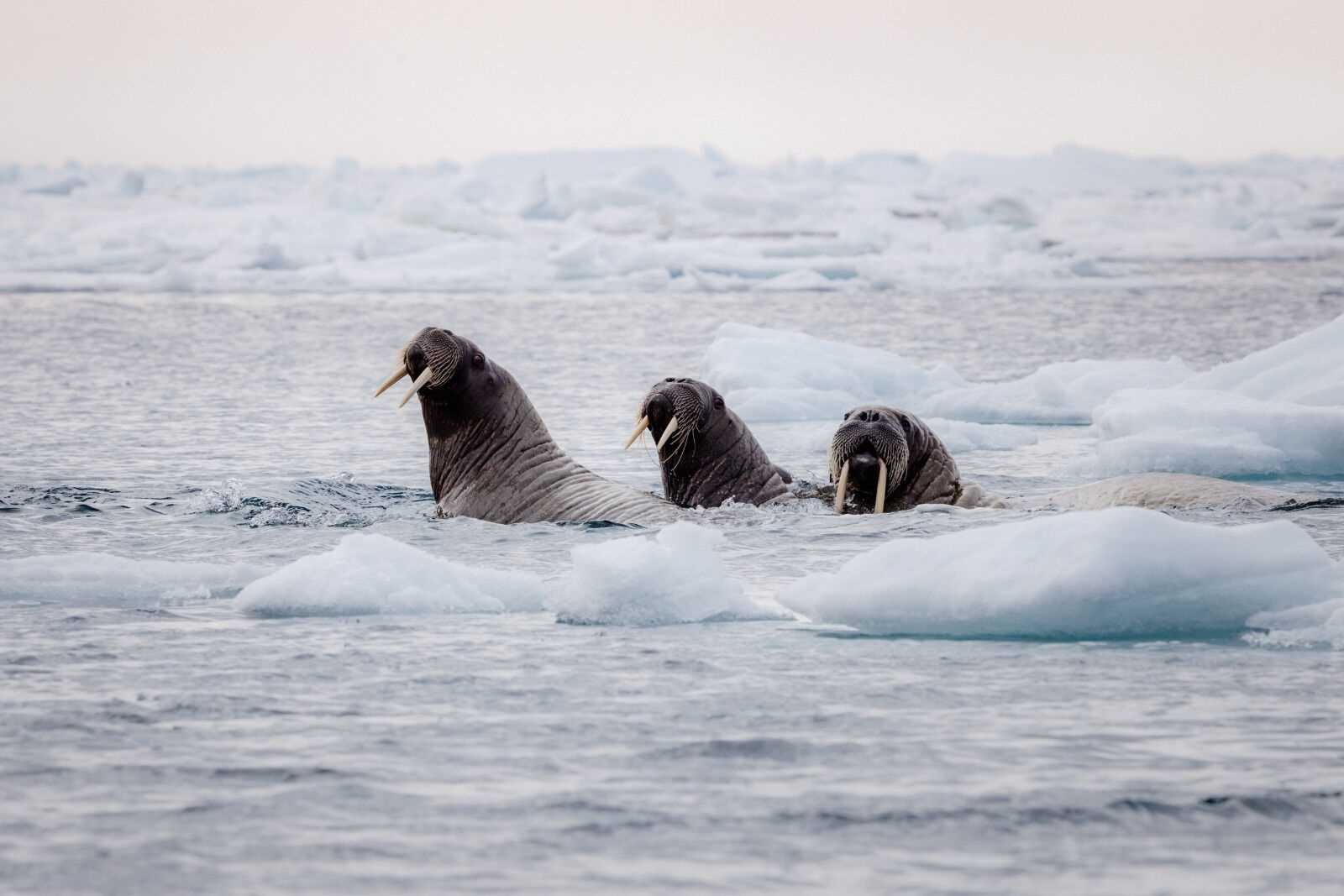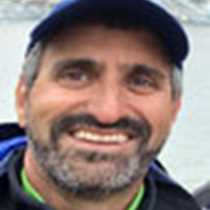National Geographic Endurance was one of the northernmost ships on the planet today as we explored the northern fringes of Svalbard amongst pack ice, walruses, and polar bears. Here, two of our Grosvenor Teacher Fellows give their impressions of the day.
Steven Zeff, Naturalist
Today was a thrilling day aboard National Geographic Endurance. Due to the optimal weather conditions, we were able to take the Zodiacs out for cruising around the Seven Islands at over 80 degrees north. The morning was crisp, cold, and lightly tinted with fog, highlighting the ethereal beauty of the region.
Entranced by the gorgeous, partially frozen landscape, we were eager to begin our tour. The magnificent waters of the Arctic Ocean were dotted with various sizes of ice in stunning shades of aquamarine blue. Cameras in hand, we snapped shots of the cavernous cliffs, gorgeous glaciers, and chunks of floating ice that looked more like dazzling gemstones than frozen water. We felt a deep appreciation for Mother Nature and her glorious artistry.
For a moment, we sat in silence and marveled at the stark wonderland around us. The water was serene and smooth, which offered spectacular reflections and made for some unbelievable photographs that resembled paintings. We also scanned the rocky walls for polar bears hiding in the deep crevices.
Our naturalists expertly navigated the frigid waters and discovered a pod of walruses. With their signature wrinkly brown and pink skin, coarse whiskers, and elegant tusks, the walruses flapped about and loudly bellowed as we took pictures to capture the moment. It was a sight to behold as we watched their blubbery bodies bobbing and weaving in and out of the water. We were elated to see these Arctic creatures in their natural habitat.
We also assisted two visiting scientists to help them collect glacial water samples to test for microplastics. Several of us volunteered to “get our hands wet” by having a bucket of water dumped on them to cleanse and prevent contamination. The polar water created a sensation of needles piercing the skin. Next, the collection vessel received the same treatment, and lastly, samples were successfully taken.
Shortly into the evening, we received an announcement from Captain Oliver summoning us quietly to the observation deck. A polar bear had been spotted. The king of the Arctic was on the ice and walking away into the mist. Much to the delight of our passengers and in dramatic fashion, he made a return and leaped into the water, taking a customary polar plunge. The bear took turns between swimming and climbing back on the ice. The excitement was palpable, and we all basked in the moment.
Traversing this part of the world has been unequivocally awesome and alarming. The Arctic is no doubt a harsh clime for its inhabitants, both human and beast. But there is something undeniably magnificent and magical about this polar place. It saddens me deeply to think about the rate at which the glaciers are eroding due to rising temperatures. Some may believe it is too late to rectify the problem, however, in the words of Nelson Mandela, “It always seems impossible until it’s done.” This is why geographic education and expedition exploration are fundamental for the longevity and preservation of our natural world in which we are currently predators instead of protectors. I plan to do my part, and I hope others will take up the pledge to do theirs.
Nikia Garland, Grosvenor Teacher Fellow
Without a sunrise, most of us found our way to observation decks or the open bridge before 7:00 a.m. after we were stirred by the deep rumbling of the ship churning through ice. Had they flown toward the ship, the guillemots bobbing in the water alongside National Geographic Endurance would have seen nothing but binoculars trained on the distant ice. Every minute spent past 80 degrees north increased our chances of spotting ice-bound wildlife – most tantalizingly, the polar bear. Our collective fortune seemed good as we spotted seals on the fringes of visibility from the ship.
The wind was far calmer than expected, and we sent out Zodiacs to explore a maze of ice that stretched between Phippsøya and Martensøya, two of the Seven Islands in Northern Svalbard. The waters were serene and glassy. As we explored the shoreline, our Zodiacs were the only interruption in a near perfect reflection of the archipelago against the deep blue-black waters. Our naturalists skillfully navigated us through the labyrinth to catch a huddle of eight to ten walruses bobbing up and down in the arctic waters. We watched quietly as they performed their graceful ballet: dipping below and re-emerging from the water, gradually turning their one to two-ton bodies in circles as they surveyed their surroundings.
We returned to National Geographic Endurance as a thick fog swept down from the archipelago to the water, and brave guests prepared for the polar plunge. While guests splashed into water with a temperature of -3 degrees C, our diving specialists sent our remote operated vehicle (ROV) twelve meters below to investigate a colorful mosaic of sediment and small aquatic plants on the seafloor. Two species of kelp (sugar kelp and finger kelp) were easily spotted in abundance. Over the last two decades, the amount of kelp has multiplied tenfold because of rising water temperatures, which is one example of a cascade of changes caused by human-induced climate change. Our footage also captured clam shells settled among the anemones and undersea kelp forests, possibly the remains of a walrus feast. Walruses can eat up to six thousand clams in a given feeding session.
Excitement swelled as we approached 81 degrees north, a milestone for many aboard and 540 nautical miles from the North Pole. According to the navigation systems used to track the passage of other ships in the region, this expedition would come closer to the North Pole than any other vessel this season. The last two weeks of (arctic) summer temperatures melted enough ice to make it passable for our expedition. This was quickly underscored by the sighting of a male polar bear just after we began to turn southward. Many guests struggled to catch sight of it through cameras and binoculars, as it spent most of its time in the water rather than on the ice. In stark contrast to the newfound welfare of kelp in northern Svalbard, we observed the polar bear in what is a shrinking territory for seal hunting.
It’s often difficult to encounter signs of environmental change, especially when we consider that the stories we tell about this expedition may be rendered completely unfamiliar to those who come after us. It’s also difficult to accept that what we see emerge from the distant fog is already vastly unlike what guests saw even ten years before at this latitude. Though we would like to think we are far from human influence – as far flung as 81 degrees N, 19 degrees E – an array of plastics washed ashore is visible even from our Zodiacs.
There is a great body of work on our cognitive biases which explains why we make the errors and misjudgments that we do. I feel that when we look back, we’ll regret dwelling so extensively on mourning what has changed around us, rather than reflecting on why our own environmentally damaging behaviors have not.
Caitlyn Homol, Grosvenor Teacher Fellow







